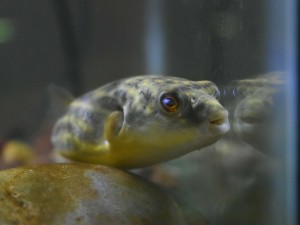

Freshwater Puffer Care Requirements and Tank Selection for Hobbyists
The Many Interesting Faces of Freshwater Puffers
Puffer fish are most recognized for their ability to expand their bodies to escape being devoured by bigger fish, but it's their "E.T." like features and distinct personalities that draw people in and make many people consider them genuine pets. They learn to identify their human friends and will excitedly meet them as they approach the tank, even hand feeding them. Puffer fish may be found all over the globe in the ocean, brackish estuaries, and freshwater settings. Some animals move back and forth between habitats on a regular basis. Fewer than 30 of the roughly 150 species of puffer fish are purely freshwater, and they are the subject of this care advice.Where is are Freshwater Puffers from exactly?
Freshwater puffers may be found in river systems in Southeast Asia, sections of India and Bangladesh, South America's Amazon basin, and Africa's Congo, Nile, and other rivers. The Gold-ringed or Mbu Puffer is even found in Lake Tanganyika ! Although a few species may be found in open water, the majority of species are located near riverbanks, frequently amid submerged vegetation. They like tropical and temperate areas to dwell in.General Water Requirements for Freshwater Puffers
Freshwater puffers thrive in water with a pH of 7.0 to 7.6 and a temperature of 74 to 78 degrees Fahrenheit. A freshwater puffer aquarium should not include aquarium salt unless it is necessary to cure infections. This is not to be confused with brackish water species like Figure 8 and Green Spotted Puffers, which are often maintained in fresh water and marketed as such in aquarium stores. Brackish water puffers may adapt to freshwater, however they are more vulnerable to illnesses, particularly ectoparasites like Ich and Oodinium, when maintained in this environment. Use an Aquarium Heater to maintain the proper water temperature if the aquarium is maintained in a room below 74°. Maintain adequate filtration and use an Aquarium Water Changer or Siphon Vacuum Gravel Cleaner to do a 10% water change every week or a 25% water change every two weeks. Before refilling your aquarium, be sure to treat tap water with Water Conditioner.General Housing Requirements For Freshwater Puffers
Caves, grottos, and overhangs should be included in the freshwater puffer aquarium to give cover and hiding places. The size of your aquarium is determined by the species you intend to maintain. Dwarf Pea Puffers (C. travancoricus), for example, may be maintained in aquariums as little as 5 gallons, but other species need 20 gallons or more. Because they spend the majority of their time inactive, some bigger species don't need as much room as you would think based on their size. The following is a list of suggested aquarium sizes for commonly found species:Dwarf Pea Puffer
Imitator Puffer
Redeye Puffer
Crested Puffer
Fang's Puffer
Emeral Puffer
S.A. Striped Puffer
Golden Puffer
Congo Puffer
Mekong Puffer
Palembang Puffer
Fahaka Puffer
Mbu Puffer
General Freshwater Puffers Behavior and Compatibility
Freshwater puffers may be fin nippers, and some are predatory and violent. Dwarf, Redeye, and Golden Puffers, for example, may be maintained together or with other fast-moving fish such as danios. Others, including the Mekong, Nile, and Mbu Puffers, must be kept alone. Freshwater puffers should be regarded species tank fish for the most part. Before acquiring puffer fish for your aquarium, always contact an aquarium specialist.Do exactly do Freshwater Puffers Eat?
Tropical Flakes, Spirulina Flakes, Tropical Granules, Algae Rounds, Bottom Feeder Tablets, and Shrimp Pellets are all good choices for smaller species. To boost development and color, frozen meals should also be provided as rewards. Cichlid pellets, Monster Fish Medley, and frozen meals may be given to larger species. Before you buy your fish, be sure you've done your homework on their nutritional needs and that you'll be able to meet them.Freshwater Puffers' Breeding Info
Although freshwater puffers have been observed to breed in captivity, it is uncommon in home tanks. Many species reproduce in caves. Captive breeding for profit is becoming increasingly widespread.





